The digital era has revolutionized how customers discover and purchase furniture. Online reviews, virtual try-ons, and augmented reality experiences have become integral parts of the furniture shopping journey.
From the latest trends shaping the industry to practical tips on enhancing your brand and the essential tips and tools to amplify your reach – this blog equips you with strategic steps to elevate your furniture store marketing.
Table of contents
- What is furniture store marketing?
- How to market a furniture store?
- 5 essential furniture marketing strategies and questions that you should evaluate
- 4 + 3 unique furniture store advertising ideas
- 5 furniture marketing tips you can use to attract more customers
- 5 important furniture marketing trends to look out for in 2024
- FAQs on furniture store marketing
- The ABCs of furniture store marketing starts with Birdeye
What is furniture store marketing?
Furniture store marketing is promoting furniture stores and their products to attract customers and increase sales. Businesses can do this through various channels, including online and offline advertising, social media marketing, public relations, and events.

How to market a furniture store?
There are many things that furniture stores can do to market themselves effectively. Among the most pivotal ones are:
- Utilize Google Business Profile
- Ensure effective business listing management
- Leverage Google for local businesses
- Develop a strong brand identity
- Create a user-friendly website
- Get listed on popular furniture review sites
- Host events and workshops
- Offer incentives and loyalty programs
- Use social media to engage with potential customers
Now, let’s delve into each of these points below in detail so you can seamlessly implement them in your marketing strategies:
1. Utilize Google Business Profile
A critical tool for marketing local furniture stores, Google Business Profile (GBP) boosts online visibility. Verified profiles increase trust and accessibility for potential customers actively searching for furniture.
Your tip:
- Offer a seamless and trustworthy experience for customers.
- Showcase products and communicate essential business details.
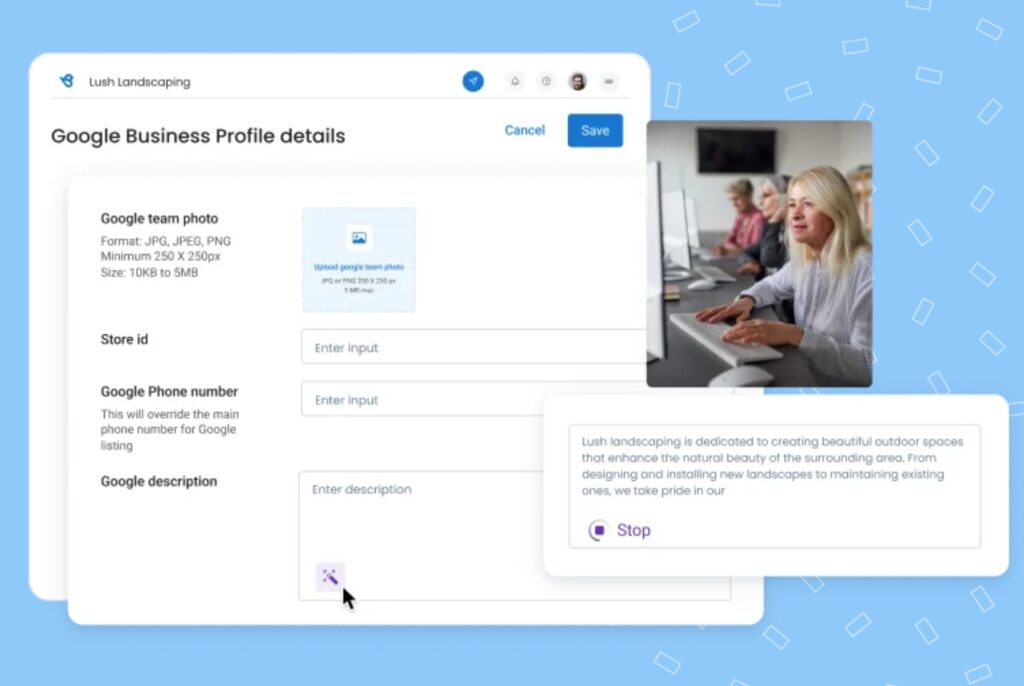
2. Ensure effective business listing management
Maintaining accurate and consistent business information across directories is key.
This becomes achievable when your business listings management is well structured. This practice improves local search optimization, making the furniture store easily discoverable.
Pro tip: Create, update, and manage business listings for all locations and better rank with Birdeye Listings.
3. Leverage Google for local businesses
Businesses must harness the power of Google to maximize their online presence. This strategy involves strategically using Google’s suite of tools to enhance visibility and accessibility. Whether it is Google ads, Google Maps
Your tip:
- Supercharge Google ad performance with Google Seller Ratings.
- Use Google Maps to provide a seamless navigation experience, guiding potential customers directly to your location.
4. Develop a strong brand identity
Many successful furniture stores prioritize creating a unique brand identity that resonates with their target audience. Brands like IKEA are known for their distinctive Scandinavian design and affordable yet functional furniture.
The consistency in their branding, from the blue and yellow color scheme to the minimalist aesthetic, establishes a strong and memorable identity.
Your tip:
- Define your brand’s personality and values.
- Ensure consistency in your logo, color palette, and messaging across all platforms.
If you run a carpet cleaning business, you must check out the 40+ carpet cleaning marketing ideas, strategies, tips & ads you can include to get more long-term customers.
5. Get listed on popular furniture review sites
Ethan Allen emphasizes its commitment to quality and craftsmanship on review sites like Houzz and Angi. By showcasing the expertise behind its furniture and highlighting positive reviews, Ethan Allen positions itself as a reliable choice for customers seeking well-crafted, high-end pieces.
Pro tip: Adding Birdeye’s Review to your furniture store marketing is a great way to begin. As the #1 reputation management platform for multi-location businesses, it helps you streamline review generation, management, and marketing by:
- Triggering review requests after a customer finishes a purchase.
- Monitoring reviews on 200+ sites.
- Personalizing your review replies with AI and generate error-free responses.
- Translating customer reviews into English and your response into your customer’s language.
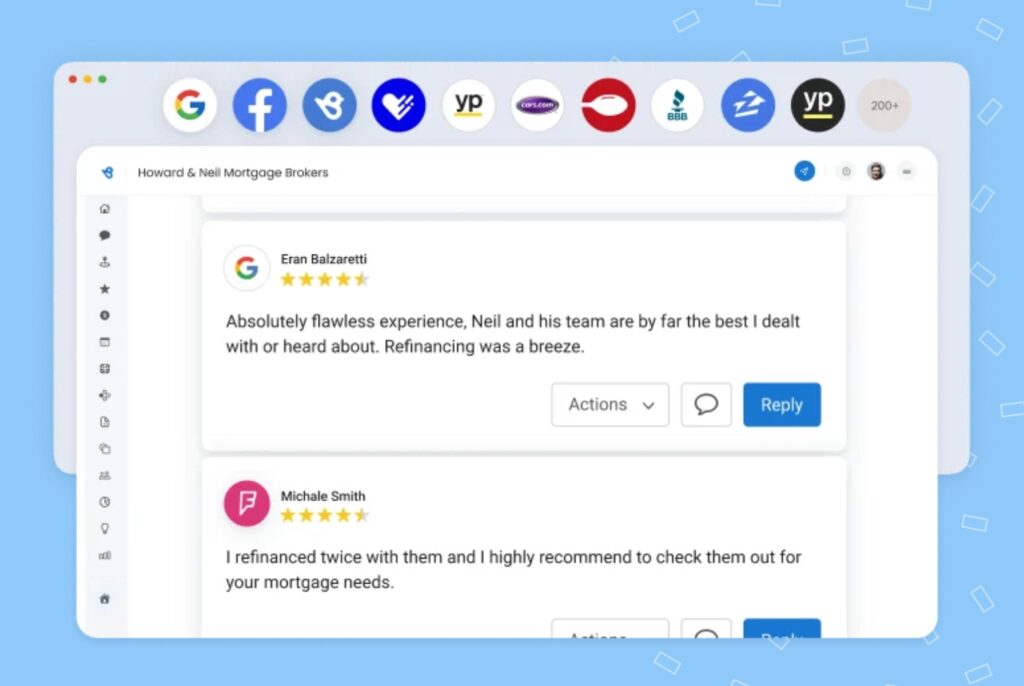
6. Create a user-friendly website
eCommerce giants like Wayfair excel in providing a seamless online shopping experience. Their user-friendly websites feature intuitive navigation, high-quality images, and detailed product descriptions.
The ease of use encourages its visitors to explore and make purchases.
2 tips for amping your furniture store marketing:
- Invest in a responsive and visually appealing website.
- Prioritize user experience with clear product categorization and an easy checkout process.
7. Offer incentives and loyalty programs
Ashley HomeStore implements a successful loyalty program. This program not only offers exclusive discounts, early access to sales, and rewards for repeat customers but also catalyzes fostering loyalty and boosting customer retention.
Pro tip:
Birdeye’s customer Referral software helps you get more leads with automated referral campaigns.
- You can easily customize your referral templates, from messaging and design to forms and rewards.
- Easily track the number of referral requests sent, shared, and new leads received from a single dashboard.
- Add referral incentives for higher response rates to maximize referral conversion.
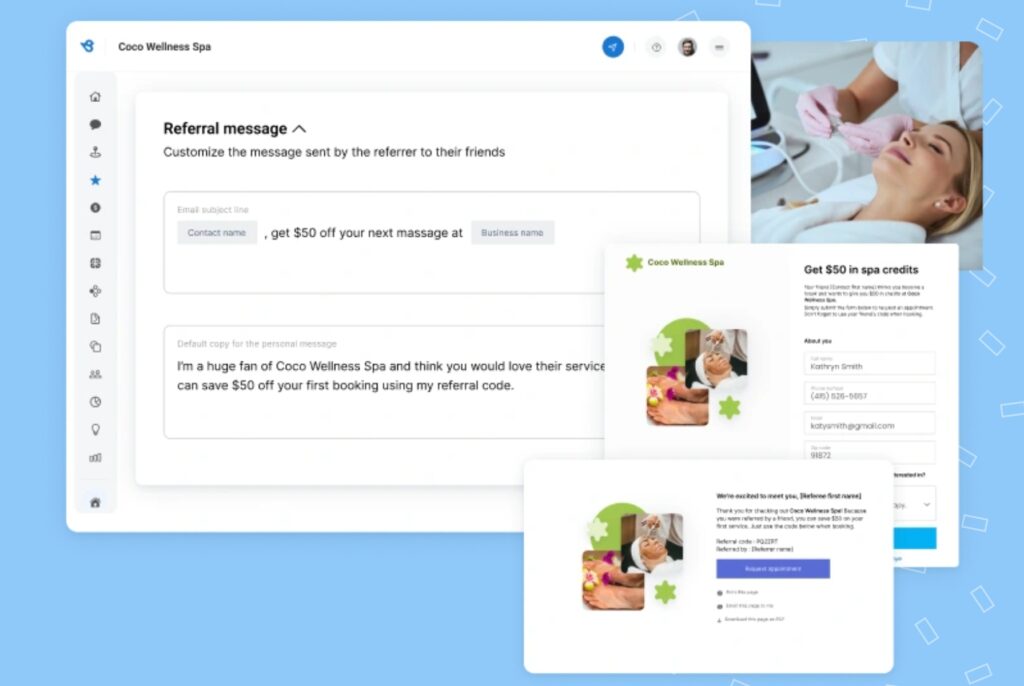
8. Host events and workshops
Furniture businesses like Crate & Barrel host in-store events and workshops, creating a community around their brand. These events offer customers a hands-on experience with the products and foster a deeper connection.
2 tips to convert leads to customers:
- Organize themed events or workshops related to furniture trends, interior design, or DIY projects.
- Engage your audience and provide value beyond the sale.
9. Use social media to engage with potential customers
Furniture brands like Restoration Hardware leverage social media platforms like Instagram and Pinterest to showcase their products in beautifully curated settings.
Creating engaging content and prioritizing influencer partnerships is an integral part of your social media management strategy.
Pro tip: Integrate Birdeye’s AI-powered Social software to:
- Generate social posts in minutes
- Monitor engagement
- Access royalty-free images & media
- Amplify your best reviews
- Measure the performance of top-performing posts
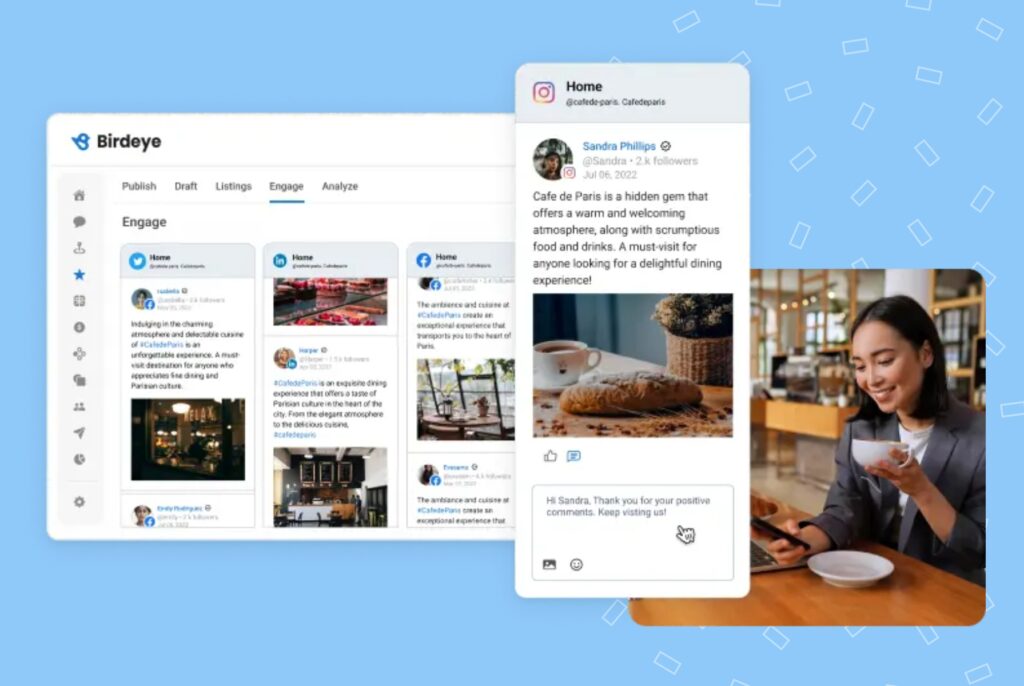
Did you know Birdeye integrates with 3,000+ CRMs and PMSs like Salesforce, HubSpot, Quickbooks, and more to help you get new reviews, be found online, improve operations, and increase revenue?
5 essential furniture marketing strategies and questions that you should evaluate
Marketing a furniture store involves a combination of traditional and digital strategies. While traditional methods like local advertising and in-store promotions remain effective, embracing digital marketing strategies, including social media and local SEO, offers a powerful way to reach a broader audience.
A balanced approach incorporating traditional and digital strategies is key to a successful furniture marketing campaign.
There are a few essential furniture marketing strategies that every furniture store should consider:
1. Knowing your target audience
Understand your potential customers’ demographics, preferences, and behaviors to tailor your marketing efforts effectively.
Here are a few questions to ask if you’re reaching your target audience:
- Who are you trying to reach with your marketing?
- What are their needs and wants?
- Are you tailoring your messaging to resonate with your ideal customers?
2. Creating a compelling brand story
An integral part of your brand reputation management should be your story resonating with customers, evoking emotions, and establishing a memorable connection.
Here are a few questions to evaluate:
- What narrative does your brand convey to customers?
- Does your brand story evoke emotions and create a connection?
- Is your brand story consistent across all marketing channels?
3. Embracing the power of digital marketing
Harness the potential of online platforms and stay ahead by implementing a comprehensive digital marketing strategy.
Before embarking on the journey of planning your marketing campaign, consider these essential questions:
- Are you utilizing online platforms to their full potential?
- Have you implemented a comprehensive digital marketing strategy?
- Are you staying updated with the latest digital marketing trends?

4. Harnessing the potential of visual storytelling
Capture your audience’s attention with visually appealing content that narrates a story about your brand and products.
Here are a few questions that will help you know if you’re doing it correctly:
- Are your product images visually appealing and high-quality?
- Does your visual content tell a story about your brand and products?
- Are you incorporating videos and other visual elements into your marketing?
5. Leveraging customer reviews
Actively encourage and respond to customer reviews, using positive feedback as a powerful tool in your marketing strategy.
Here are a few questions to know if you’re acing your review management:
- Are you actively encouraging customers to leave reviews?
- Do you respond promptly to negative customer reviews also?
- Are you using positive reviews in your marketing materials?
Mastering Furniture Store Marketing: Trends, Strategies, and Success Stories
Want to see the impact of Birdeye on your business? Watch the Free Demo Now.
4 + 3 unique furniture store advertising ideas
Unlike the marketing strategies and tips mentioned above, furniture store advertising ideas focus on inventive approaches to showcase products and engage customers.
In contrast to the marketing strategies and tips mentioned above, furniture store advertising ideas zero in on inventive approaches to showcase products and engage customers.
It’s crucial as it captivates attention, promotes brand uniqueness, and drives customer interest, contributing to increased foot traffic and sales for furniture stores.
Furniture store advertising ideas involve creative promotions. Incorporating these into your brand strategy will undoubtedly benefit you. Here are four unique furniture store advertising ideas:
- Enhance customers’ online shopping experience by allowing them to visualize products in their homes with AR technology virtually.
- Send promotions and discounts directly to potential customers based on their location.
- Launch a subscription service for curated furniture pieces.
- Experiment with ads for furniture by hosting a podcast to connect with potential customers through captivating narratives about your furniture.
Apart from the furniture advertisement ideas, here are three additional concepts to make your furniture store advertising truly unique:
- Use humor and creativity in your advertising.
- Target your advertising to your ideal customer.
- Track your advertising results and make improvements as needed.
Unlock the power of strategic furniture store marketing with Birdeye. Visit our pricing page to discover tailored solutions for boosting your brand and delighting customers.
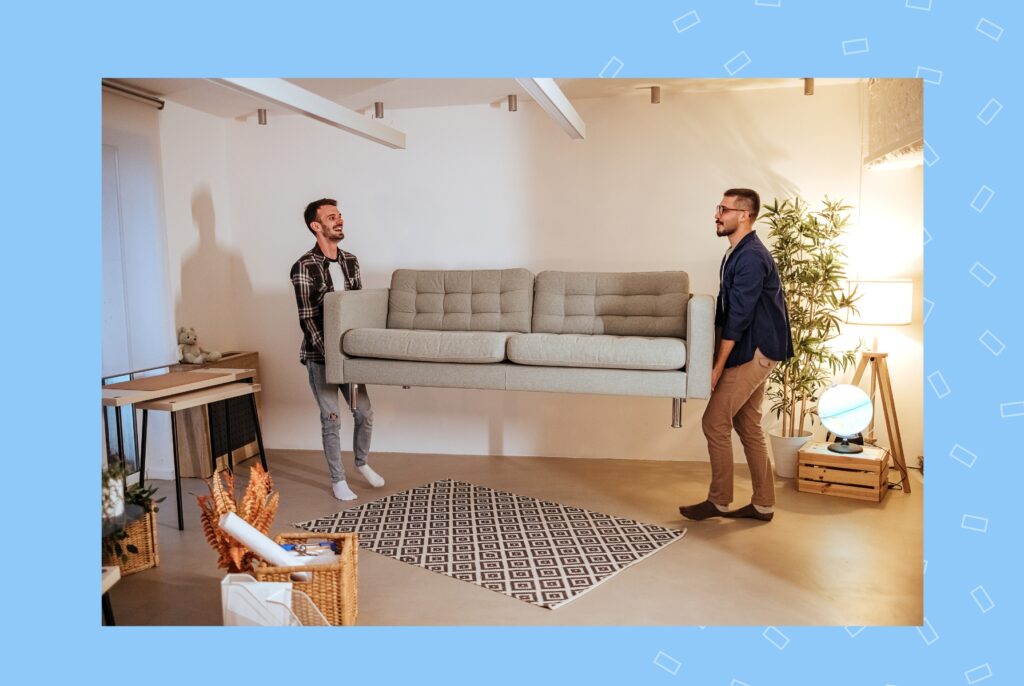
5 furniture marketing tips you can use to attract more customers
Unlike strategies and advertising ideas, these furniture marketing tips provide specific, actionable guidance for daily operations, ensuring a consistent and effective marketing approach for sustained growth.
Here are the top five you should be implementing:
- Create a custom furniture line.
- Partner with a local interior designer to create a styled showroom.
- Share customer stories on your website and review sites.
- Promote user-generated content to feel more relatable to your customers.
- Show behind-the-scenes snapshots of the manufacturing process and staff preparing for events and workshops.
5 important furniture marketing trends to look out for in 2024
Do you know what makes a brand’s furniture store marketing strategy successful?
It’s the understanding and adaptation to market trends.
From predicting furniture styles and materials to consumer preferences– everything is evolving. Furniture store business owners can adapt their inventory and marketing strategies by staying informed about the latest trends.
Here are a few current trends that will ensue in 2024:
1. Augmented reality’s try-before-you-buy
Augmented reality (AR) and virtual reality (VR) are becoming increasingly popular technologies and will likely play a bigger role in furniture marketing in 2024.

As per recent research, the largest market segment within the AR & VR market is software. It is projected to reach a market volume of US$11.9bn in 2023. This is because new-age shoppers believe such feasibility influences them to shop more.
AR apps enable consumers to visualize home furniture, while VR apps provide a more immersive furniture experience.
What you can do: Enhance the online shopping experience by integrating AR directly into your advertising, making it fun and practical for potential buyers.
2. Sustainability and ethical sourcing
Consumers are increasingly becoming more conscious of the environmental and ethical impact of their purchases. This trend is likely to continue in 2024, and furniture stores will need to:
- Use recycled or repurposed materials.
- Partner with suppliers who have ethical labor practices.
- Communicate the sustainability credentials to consumers.
3. Omnichannel marketing
Omnichannel marketing is becoming increasingly important as consumers shop across different channels.
Furniture stores must ensure that their website, social media presence, and physical store are all integrated and working together to provide a positive customer experience.
4. Using AI to their advantage
AI in marketing is being used to automate and personalize marketing campaigns. This trend will likely continue in 2024, and furniture stores can use AI to improve their targeting, personalization, and customer service.

5. Voice search optimization (VSO)
Voice search is becoming increasingly popular, and furniture stores must ensure that their websites are optimized for voice search. This could involve using long-tail keywords, creating natural language content, and optimizing for local search.
Use Birdeye’s AI-powered Lisiting platform to show where your customers search. It helps improve your SEO ranking and attract more customers with AI-generated business descriptions that you’re customers are looking for.
FAQs on furniture store marketing
Engage with compelling displays, promotions, and a strong online presence to attract more customers to your furniture store.
Use diverse channels like social media, print, and digital marketing to advertise your furniture business.
The 7ps of marketing for furniture business are: Product, Price, Place, Promotion, People, Processes, and Physical evidence.
Homeowners, renters, and businesses seeking quality and style at various price points are the target market for furniture stores. Create a unique brand strategy to appeal to all these market segments.
Utilize local partnerships, print advertising, community events, and direct mail to market your furniture store offline.
Track website traffic, conversions, and sales, and gather customer feedback through surveys.
Common mistakes furniture store marketing to avoid are: Neglecting online presence, ignoring customer reviews, underestimating local SEO, and disregarding current furniture trends.
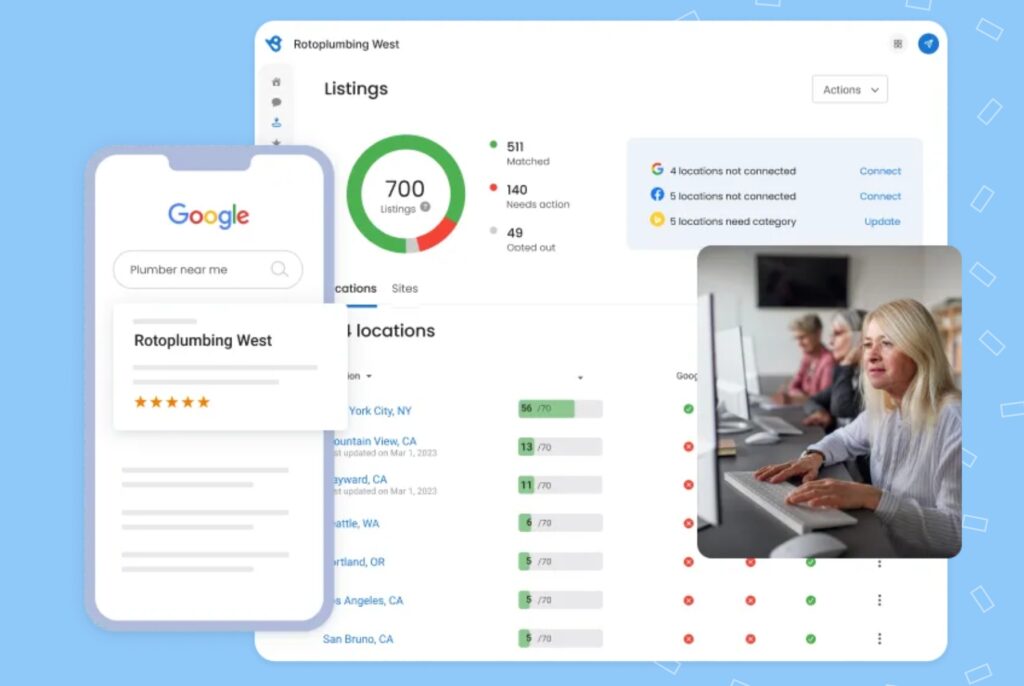
The ABCs of furniture store marketing starts with Birdeye
The above-mentioned furniture store marketing strategies, tools, trends, and tips involve offline and online best practices to help your business generate more revenue, improve its reputation, and make customers a brand evangelist.
Click on the banner below to speak with our CX expert to learn how Birdeye can help you improve your furniture store marketing strategy in our next successful case study.

Originally published




![[Feature image] Starting a business in Australia-the complete roadmap for 2025](https://birdeye.com/blog/wp-content/uploads/Feature-image-Starting-a-business-in-Australia-the-complete-roadmap-for-2025-375x195.jpg)




